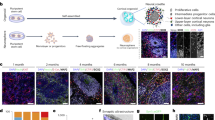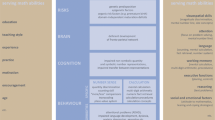Abstract
Cortical development is a complex process where a multitude of factors, including cadherins, plays an important role and where disruptions are known to have far reaching effects in neural development and cortical patterning. Cadherins play a central role in structural left–right differentiation during brain and body development, but their effect on a functional level remains elusive. We addressed this question by examining functional cerebral asymmetries in a patient with Van Maldergem Syndrome (VMS) (MIM#601390), which is caused by mutations in DCHS1-FAT4 cadherins, using a dichotic listening task. Using neurophysiological (EEG) data, we show that when key regulators during mammalian cerebral cortical development are disrupted due to DCHS1-FAT4 mutations, functional cerebral asymmetries are stronger. Basic perceptual processing of biaurally presented auditory stimuli was unaffected. This suggests that the strength and emergence of functional cerebral asymmetries is a direct function of proliferation and differentiation of neuronal stem cells. Moreover, these results support the recent assumption that the molecular mechanisms establishing early left–right differentiation are an important factor in the ontogenesis of functional lateralization.

Similar content being viewed by others
References
Beste C, Saft C (2015) Action selection in a possible model of striatal medium spiny neuron dysfunction: behavioral and EEG data in a patient with benign hereditary chorea. Brain Struct Funct 220:221–228
Beste C, Mückschel M, Elben S, Hartmann CJ, McIntyre CC, Saft C et al (2014) Behavioral and neurophysiological evidence for the enhancement of cognitive control under dorsal pallidal deep brain stimulation in Huntington’s disease. Brain Struct Funct. doi:10.1007/s00429-014-0805-x
Bloom JS, Hynd GW (2005) The role of the corpus callosum in interhemispheric transfer of information: excitation or inhibition? Neuropsychol Rev 15:59–71
Brandler WM, Paracchini S (2014) The genetic relationship between handedness and neurodevelopmental disorders. Trends Mol Med 20:83–90
Brandler WM, Morris AP, Evans DM, Scerri TS, Kemp JP, Timpson NJ et al (2013) Common variants in left/right asymmetry genes and pathways are associated with relative hand skill. PLoS Genet 9:e1003751
Bystron I, Blakemore C, Rakic P (2008) Development of the human cerebral cortex: Boulder Committee revisited. Nat Rev Neurosci 9:110–122
Capello S, Gray MJ, Lange S, Einsiedler M, Srour M, Hamdan FF et al (2013) Mutations in genes encoding the cadherin receptor-ligand pair DCHS1 and FAT4 disrupt cerebral cortical development. Nat Genet 45:1300–1308
Crawford JR, Garthwaite PH (2012) Single-case research in neuropsychology: a comparison of five forms of t test for comparing a case to controls. Cortex 48:1009–1016
Dorsaint-Pierre R, Penhune VB, Watkins KE, Neelin P, Lerch JP, Bouffard M et al (2006) Asymmetries of the planum temporale and Heschl’s gyrus: relationship to language lateralization. Brain 129:1164–1176
Eichele T, Nordby H, Rimol LM, Hugdahl K (2005) Asymmetry of evoked potential latency to speech sounds predicts the ear advantage in dichotic listening. Brain Res Cogn Brain Res 24:405–412
Gadea M, Marti-Bonmatí L, Arana E, Espert R, Salvador A, Casanova B (2009) Corpus callosum function in verbal dichotic listening: inferences from a longitudinal follow-up of relapsing-remitting Multiple sclerosis patients. Brain Lang 110:101–105
Hugdahl K (2000) Lateralization of cognitive processes in the brain. Acta Psychol (Amst) 105:211–235
Hugdahl K, Nygård M, Falkenberg LE, Kompus K, Westerhausen R, Kroken R et al (2013) Failure of attention focus and cognitive control in schizophrenia patients with auditory verbal hallucinations: evidence from dichotic listening. Schizophr Res 147:301–309
Mendes RV, Martins GG, Cristovão AM, Saúde L (2014) N-cadherin locks left–right asymmetry by ending the leftward movement of Hensen’s node cells. Dev Cell 30:353–360
Mückschel M, Stock A-K, Beste C (2014) Psychophysiological mechanisms of interindividual differences in goal activation modes during action cascading. Cereb Cortex 24:2120–2129
Neuhann TM, Müller D, Hackmann K, Holzinger S, Schröck E, Di Donato N (2012) A further patient with van Maldergem syndrome. Eur J Med Genet 55:423–428
Nunez PL, Pilgreen KL (1991) The spline–laplacian in clinical neurophysiology: a method to improve EEG spatial resolution. J Clin Neurophysiol 8:397–413
Ocklenburg S, Arning L, Hahn C, Gerding WM, Epplen JT, Güntürkün O et al (2011) Variation in the NMDA receptor 2B subunit gene GRIN2B is associated with differential language lateralization. Behav Brain Res 225:284–289
Ocklenburg S, Arning L, Gerding WM, Epplen JT, Güntürkün O, Beste C (2013) FOXP2 variation modulates functional hemispheric asymmetries for speech perception. Brain Lang 126:279–284
Oldfield RC (1971) The assessment and analysis of handedness: the Edinburgh inventory. Neuropsychologia 9:97–113
Petzoldt AG, Coutelis JB, Géminard C, Spéder P, Suzanne M, Cerezo D, Noselli S (2012) DE-Cadherin regulates unconventional Myosin ID and Myosin IC in Drosophila left–right asymmetry establishment. Development 139:1874–1884
Vallortigara G, Rogers LJ (2005) Survival with an asymmetrical brain: advantages and disadvantages of cerebral lateralization. Behav Brain Sci 28:575–589
van Maldergem L, Wetzburger C, Verloes A, Fourneau C, Gillerot Y (1992) Mental retardation with blepharo-naso-facial abnormalities and hand malformations: a new syndrome? Clin Genet 41:22–24
Zakaria S, Mao Y, Kuta A, Ferreira de Sousa C, Gaufo GO, McNeill H et al (2014) Regulation of neuronal migration by Dchs1-Fat4 planar cell polarity. Curr Biol 24:1620–1627
Acknowledgments
This study was supported by a Grant from the Deutsche Forschungsgemeinschaft BE4045/10-1 and 10-2 to C.B.
Author information
Authors and Affiliations
Corresponding author
Additional information
C. Beste and S. Ocklenburg contributed equally.
Rights and permissions
About this article
Cite this article
Beste, C., Ocklenburg, S., von der Hagen, M. et al. Mammalian cadherins DCHS1-FAT4 affect functional cerebral architecture. Brain Struct Funct 221, 2487–2491 (2016). https://doi.org/10.1007/s00429-015-1051-6
Received:
Accepted:
Published:
Issue Date:
DOI: https://doi.org/10.1007/s00429-015-1051-6




